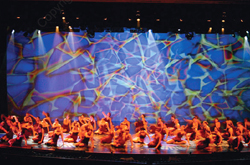
Finishing The Lighting Plot
Once the key, fill, and back lights are laid into the lighting plot, then the rest of the set can be lit. Unless there are specific requirements of the lighting, as in theatrical productions where specials are used to accent the composition or to light special objects, then the designer can be free to add lights to create mood and enhance the aesthetics of the production.
Automated lighting excels at color wash and image or beam projection.
Color Wash
Soft-edge, color-changing automated lights can be used in two basic ways: to light the surfaces of objects like cycs, set pieces, performers, etc. or to create shafts of aerial beams in the air. To light set pieces the fixtures are typically placed on balcony rails, a front of house (FOH) truss, a downstage truss, or, in some instances, a side truss.
In rock and roll shows where aerial beams are often emphasized, they’re often placed on upstage or mid-stage truss, on truss pods or stands, or on fl oor stands where they can produce upward pointing shafts of light.
Most automated color wash luminaires use dichroic color changers with discharge lamps, both of which have some unique characteristics. Dichroic color lends itself to more saturated color than gel filters, and the range of colors from a discharge lamp is somewhat limited compared to an incandescent lamp.
Technically speaking, an automated light with 8-bit CMY color mixing has 196,608 unique color combinations, but the visible differences are limited by the spectral distribution of the lamp and the characteristics of the dichroic color mixing filters.
If the show is being videotaped or if there’s I-mag, then the cameras and displays introduce another factor in the final rendering of the color. In those instances it’s important for the designer to monitor the video display to see how the rendered scene looks on camera.
Image & Beam Projection
The complement to color wash is image and beam projection provided by profile spot fixtures. In general, spot fixtures located more toward the downstage position can be used more effectively for projecting images on upstage set pieces. The longer the throw, the larger the diameter of the projection and the lower the illuminance on the projection surface. (Remember the inverse square law!)
In rock and roll shows, aerial beams are typically a very important part of the design; therefore, many designers place a number of profile spots in upstage and midstage positions as well as on lighting pods, lighting stands, and floor stands, and they use an interference medium like fog or haze. Without interference there are no aerial beams to be seen.
Also, beams that are projected toward the audience look brighter than those projected away from the audience.
Lighting design is very often a compromise between the designer’s vision and the reality of the budget for a production. Given a large enough budget, having profile spot fixtures in a number of different positions provides great flexibility in building scenes.
Spots in FOH positions can paint scenic elements or drops, providing a nice canvas for pattern projection or for creating texture with shape, form, light, and shadow.
Spots in side positions can help sculpt a subject with hard or soft light, bringing form and definition to the subject. Placing spots in the upstage positions allows for aerial beam projection with very interesting cones, tunnels, and other laser-like effects. The same upstage spot fixtures positioned on the floor provide another vantage point from which to create aerial projections.
The more varied and diverse positions you can find, the more interesting scenes you can create.
A final lighting design should cover all the bases for achieving your design goals. It should provide the right amount of illuminance for the project, enough contrast between light and dark to reveal the subject, and enough color, projection, and effects to match the aesthetics of the production. In the final analysis, the success of the lighting design is measured by the response of those who experience it.
Read part 1 of this article here.
——————————————-
Go here to acquire Automated Lighting, 2nd Edition, published by Focal Press. Use the promo code FOC20 during checkout to receive a 20 percent discount.
——————————————
Richard Cadena is the technical editor for PLASA, an authorized WYSIWYG trainer, and 20-year veteran of the entertainment lighting industry including stints with two of the world’s largest automated lighting manufacturers. He has a background in electrical engineering and electronics, and he is a freelance lighting designer with a portfolio of several major lighting designs and installations and is proficient in WYSIWYG, LD Assistant, and Vectorworks.
